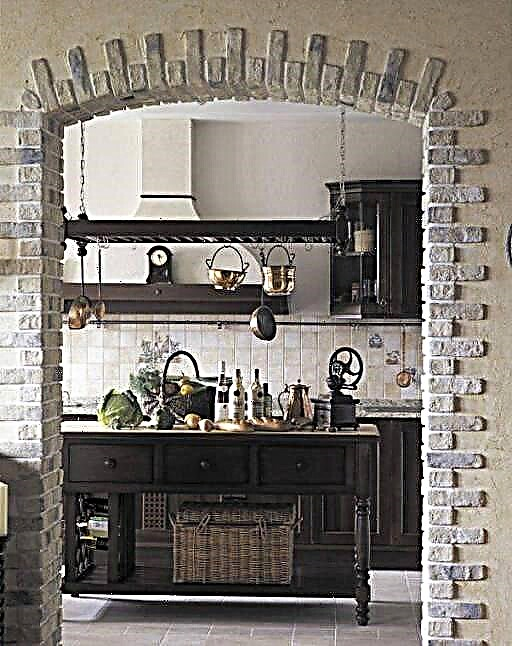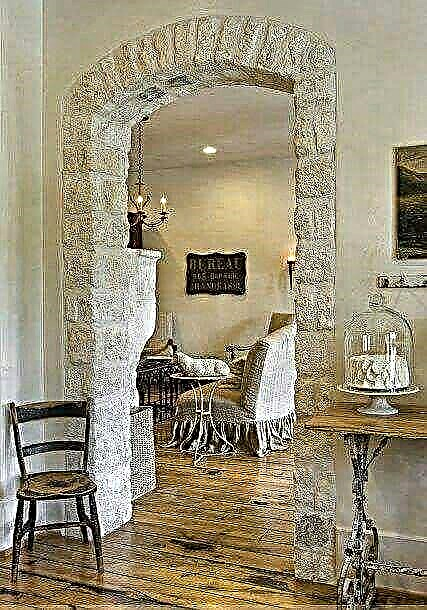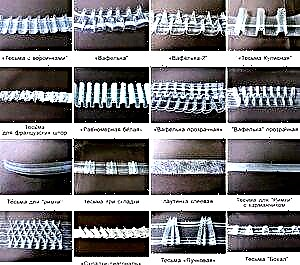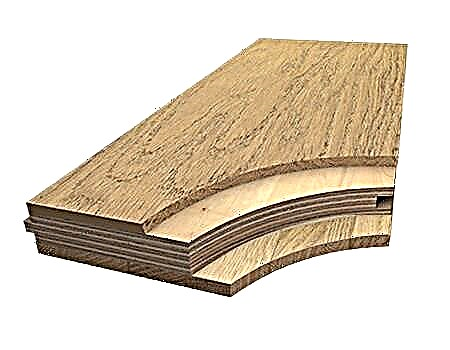Your repost will change the Internet :)
Wall decoration with decorative stone goes well with wallpaper. This option is suitable for the interior of the hallway, and for the design of walls in the kitchen space. Two types of stones are used for repairs: they are created from artificial concrete or gypsum.
Wallpaper and thin-layer decorative material in the lining of the kitchen.
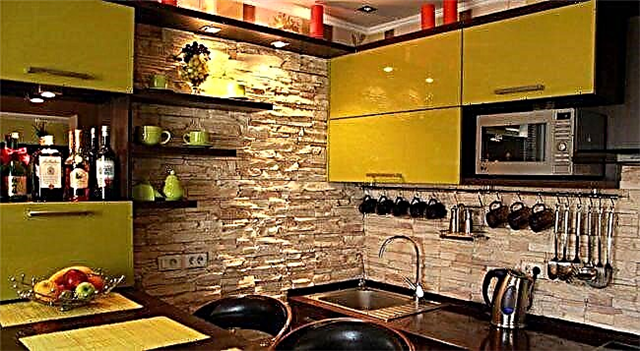

Material Features
It is much easier to work with artificial gypsum stone, since the desired shape can be easily cut. However, the cost of concrete elements is almost 2 times less. For many, this factor is determining in the process of choosing a finishing material.
A bright solution using artificial slate of different colors. The photo shows the entrance hall and part of the kitchen.

Benefits:
- The cost of repair is less when compared with the lining with natural elements,
- The appearance of the material is as close as possible to the natural texture,
- The weight of artificial tiles is negligible, respectively, the walls do not experience a significant load. In addition, it’s quite easy to lay light elements, creating a flat surface,
- Due to its ecological composition, it can be used for interior decoration,
- A fungus does not form on such a stone, since the rotting process is not supported,
- Easy maintenance care
- High strength performance. This factor is important, because the kitchen and hallway belong to the most visited part of your house,
- A large selection of shades will effectively combine the stone with wallpaper.
Disadvantages:
- Price. Finishing with decorative stone material does not apply to economical options,
- For many, the minus is the cold surface of the elements,
- The material is exposed to high temperature, so when choosing it is important to consider the purpose of the room and the operating conditions.
Tips for installing decorative stone

1. First you need to prepare the walls in the room, namely to clean the surface of the remnants of plaster and wallpaper.
2. For repair work you will need a household tool,
3. Before starting work, it is necessary to plan the lighting system and organize the wiring.
4. The surface is leveled using putty or gypsum plaster. Drywall is selected in the event that LED illumination is planned - the gap between the sheets and the wall allows the integration of devices.

5. For installation, use a special adhesive composition, a solution of putty or “liquid nails”. The most popular option is laying tiles on glue.
6. If necessary, the seams between the elements are filled with a solution.
Photos of completed projects
Combined decoration.
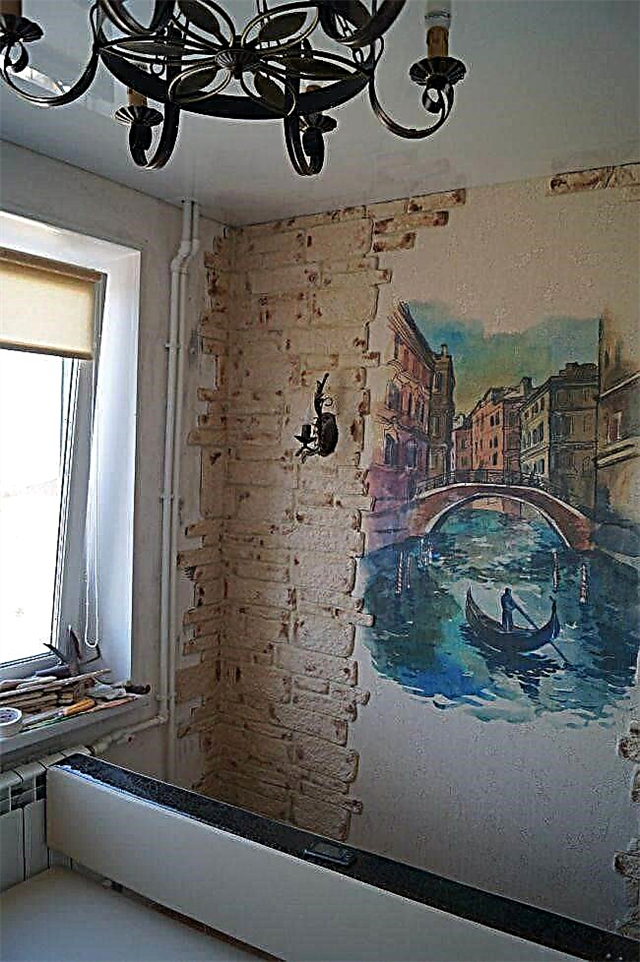

A bar that separates the entrance hall and kitchen-living room. For cladding, decorative brick was used.

The decoration of the walls of the hallway - wallpaper and slate.

For the decoration of the kitchen used plain wallpaper and slate.

The gamma of the interior of the hallway repeats the colors used in the kitchen.

Cobblestone lining of the bar and wall surface. Artificial material is complemented by a pistachio-colored wallpaper.

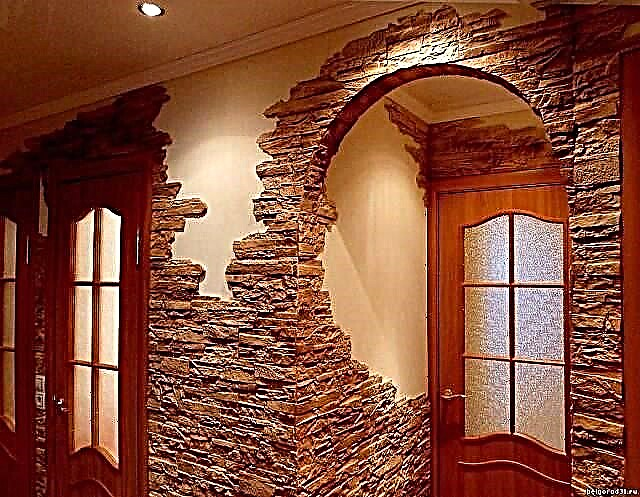
To design the apron and column area in the kitchen, a collection of bricks with different tones was chosen.
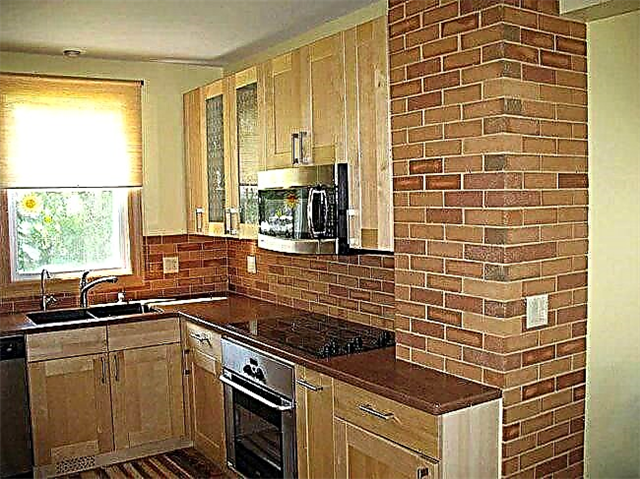
Highlighting the dining area in the interior of the kitchen with a brick wall.


Light shades in the design of the kitchen-dining room.

A palette of pastel colors in the hallway.




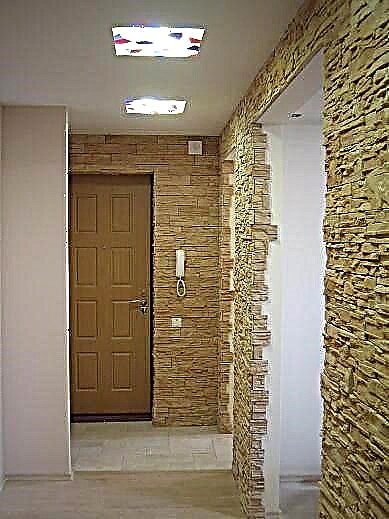
Rich colors in the design of the hallway with the use of curly slate.
The advantages of decorative stone
A demanded building material for the decoration of kitchens is decorative stone. This material impresses consumers with an aesthetic appearance and good technical characteristics. Decorative stone has a lot of advantages, namely:
- wide range of textures and color schemes,
- long term of operation,
- resistance to negative factors,
- resistance to mechanical damage,
- strength and reliability
- environmental friendliness and safety.
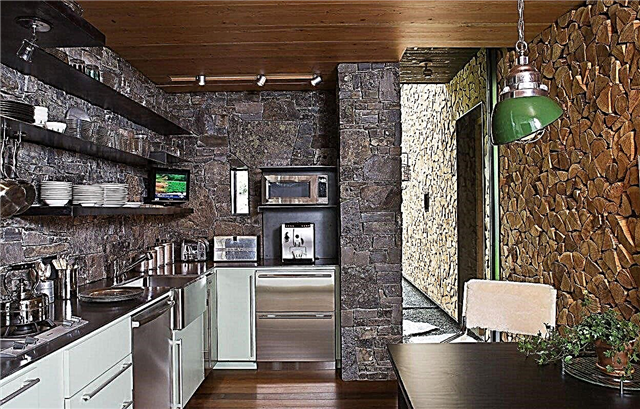
Highlight the kitchen area with a coarse sandstone stone texture
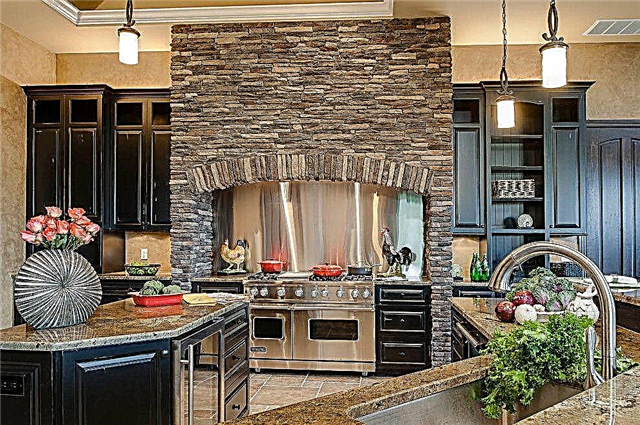
Decorating with a decorative stone stove in the style of an old stove
It is easy and simple to work with. It is sawn and drilled with various improvised tools.
Designers recommend the use of decorative stone in the areas of Provence, country. And also in a medieval style.
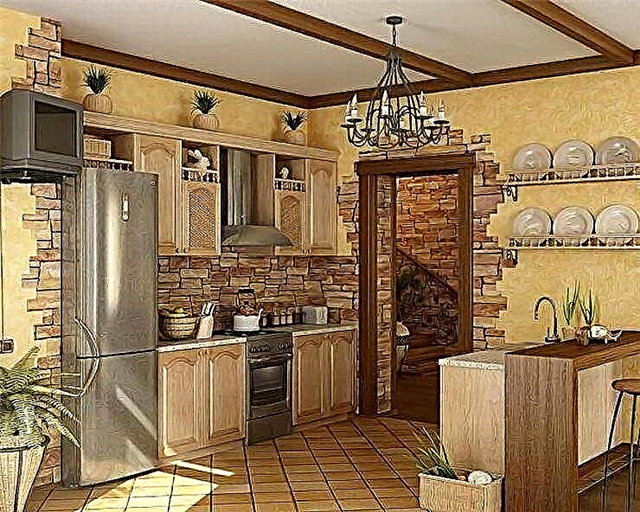
Finishing an apron kitchen style provence decorative stone

The stone is well suited for background decoration of the walls of a country-style kitchen

Large cobblestone walls fit perfectly into the rustic style

Decorating the kitchen wall with loft-style decorative stone
Decorative stone does not like bright lighting. Therefore, it is recommended to make dim lighting. If the material is finished with a work surface or an apron, there should be a lot of light in this zone.
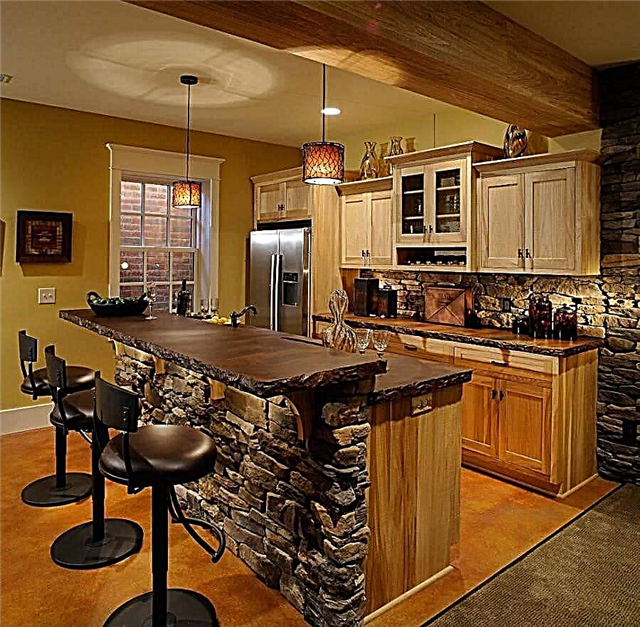
Soft dim light gives the decorative stone a warm shade
Designers love to combine decorative stone with natural greenery. To emphasize the individuality and originality of the kitchen, put ampelny flowers.

Flowers and greenery will enliven the interior of the kitchen when decorated with decorative stone
Also, decorative stone in harmony with rough cobblestones in the interior, wicker furniture and aluminum.
Important! For small rooms it is worth choosing small tiles of artificial stone. Since large elements will overload the room.
Dilute decorative stone with softer finishing building materials, for example, wallpaper, decorative plaster and other decorative elements.
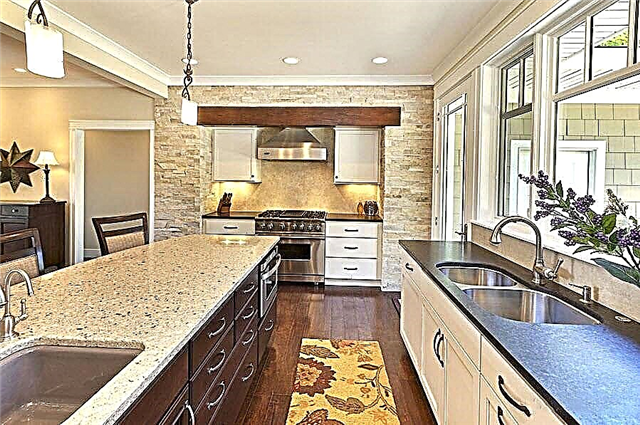
Light finish stone blends well with decorative plaster

A single column, trimmed with stone, against the background of dim wallpapers
Material Care Features
A decorative stone is unpretentious in leaving. It is recommended to clean it with a vacuum cleaner or you can carry out dry and wet cleaning.
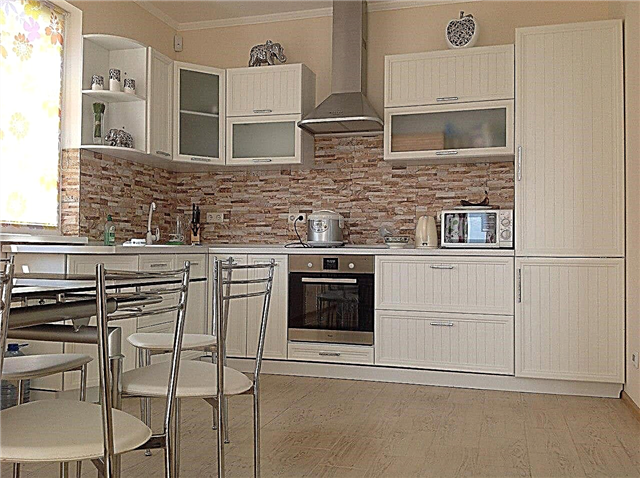
Undemanding in cleaning and resistance to damage are the main advantages of decorative stone
For wet cleaning a spray is used. Spray the water evenly over the surface, it will collect dust and drain down. You just need to wipe the floor later.

Finishing stone is easily washed with water and any detergents.
If the apron is laid out with artificial stone, you will need to use cleaning products.
Use any detergents to clean the work surface.
Step-by-step instructions for wall decoration
If you decide to finish the walls with artificial stone, you will need to do some small preparatory work. To begin with, the walls are leveled with cement or putty, then a primer is applied to them and you can proceed to the decorative finish.
Important! When processing walls in the kitchen with a primer, it is advisable to use antiseptic agents.
To lay artificial stone on the walls, prepare the following tools:
- grinder
- putty knife,
- file,
- building level,
- rollers, brushes.
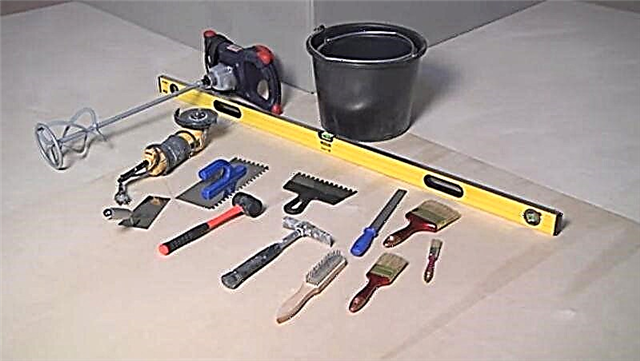
Stone doesn’t need a lot of tools
Phased work is as follows.
- Remove dust and dirt from the processed surfaces.
- Treat the walls with an antifungal primer and wait for it to dry.

Carefully level the walls before laying the finishing stone
- Remove the finishing material from the packaging and place it on a flat surface. This will help to choose the material by color, texture, thickness.
- Mark the walls to see how the decorative stone will look on the walls.
Important! Do not forget to count the distance of the seams. The width of the seam varies depending on the type of masonry and the type of material used.
- Laying of the material begins with corner elements. You can start installation from both the top and bottom edges of the wall. If you will be using masonry technology with jointing, start work from the top edge. Without jointing, work starts from the bottom.
Important! Laying artificial stone from the top edge will prevent the adhesive from getting onto the finishing material. And laying from the bottom edge will prevent the material from sliding along the wall.
- Prepare the adhesive mortar according to the manufacturer's instructions and apply it on the decorative stone and on the wall.
- Attach the decorative stone to the wall, push on it, and knock with a rubber mallet.
- 40 minutes after the glue hardens, remove the rest with a spatula.

The thickness of the mortar on the wall should not exceed 5 mm
Interesting ideas for wall decoration in the kitchen
Decorative stone blends harmoniously with the wallpaper. For the kitchen, it is recommended to use plain wallpaper and slate. A combination of the same colors in the kitchen and in the hallway will look original. Such a design will visually enlarge the room, and make it spacious and bright.

Finishing stone can serve as a frame for wallpaper with photo printing
If you want to highlight the bar, clad it with large material, and paste over the walls with pistachio wallpaper. The allocation of the dining area with the help of brickwork also looks original. If your kitchen and dining room are connected, choose light and gentle colors.
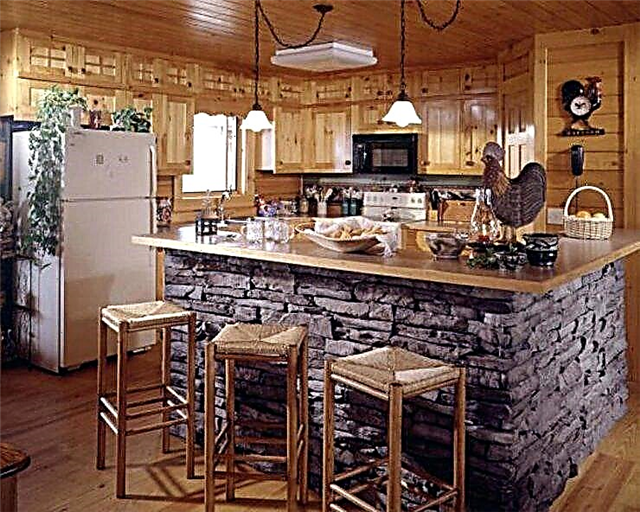
Monumental bar counter trimmed with decorative stone

Imitation of a niche in a stone wall in combination with a tiled apron

Decorative stone should be combined with the tone and color of the furniture

Use asymmetric masonry made of stone as a background for hinged elements of the kitchen interior
Finishing Benefits
A stone wall in the kitchen has a number of advantages, including durability and strength, there is no need to often redecorate it. In addition, it is environmentally friendly and easy to install on the wall material, which requires minimal maintenance, is presented in a wide selection of designs and types.
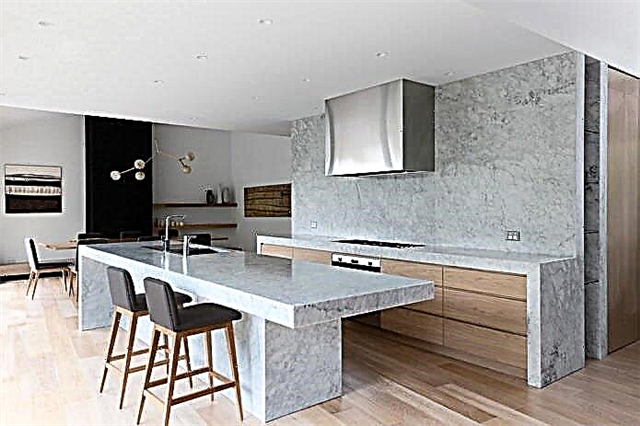
Decorative stone on the wall can be purchased in the right size and at an affordable price, which will not burden the surface of the wall.

Artificial (decorative) stone
It differs little in appearance from natural, repeats its shape, texture and size. It weighs less than natural, made from sand and cement.

On the practical side, artificial is not inferior to natural, it can be made in any color, and the kitchen can be decorated in a different version. It easily adheres to the surface, is shockproof and wear-resistant.
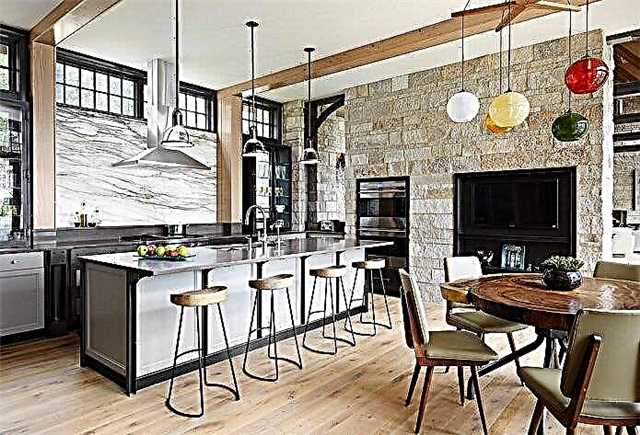
Wild (natural) stone
It is distinguished by its unique origin and unique exclusivity. Natural masonry carries the energy of naturalness, which fills the kitchen with cosiness. Durable, does not require special care, shockproof, tolerates changes in moisture and temperature.


In the photo there is an eco-style kitchen with a natural stone on the wall, which is highlighted with spots to create a cozy atmosphere.
Slate
It happens yellow, brown, burgundy, green and multi-colored. Thin thickness and flat surface are suitable for bedding.

Pictured is a slate wall in a modern kitchen that is easy to clean and has a high lifetime guarantee.
Pebbles
Pebbles of river or rock of different colors require cleaning to avoid mold in the spaces between the stones, if it is a surface in a kitchen with high humidity, or an apron.

In the photo, the work surface in black is made of pebbles, which is evenly recessed into the cement and sanded to a smooth surface for easy cleaning.
Under the stone
It has many varieties, including facing, mounting stones on a flat surface with a glue mixture.

A flat view of the kitchen wall is laid with a die, while it is necessary to select and lay so that there are no obvious voids. Volumetric masonry made of thin stone can be laid evenly or in relief.
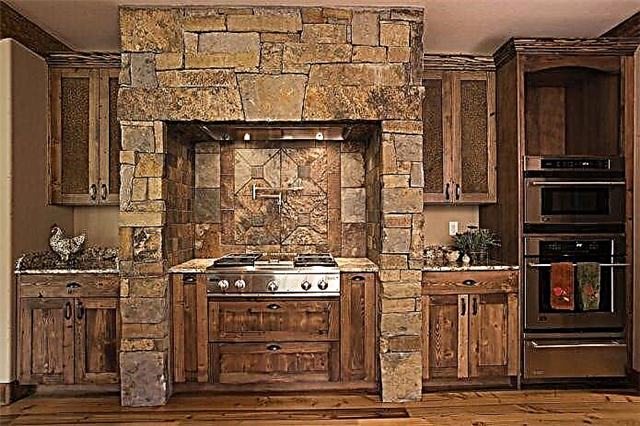
Under the brick
The stone in the kitchen can be laid with American, English, Flemish dressing.

In the photo, the wall in the working area is faced with granite and a niche is made of brickwork under the stylization of a rustic stove.
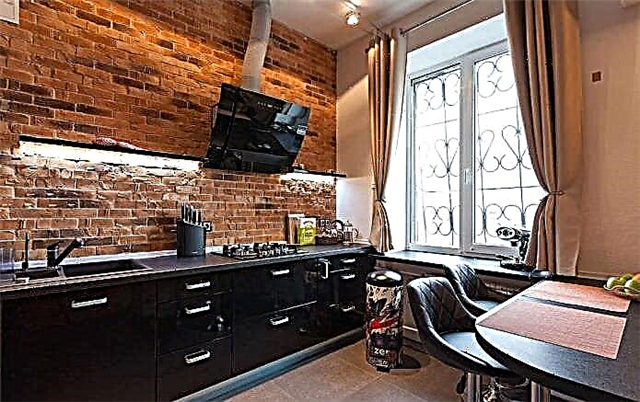
Facing "Castle" imitates the laying of medieval fortifications. The same rectangular stone is laid according to the Shahriar type.

In the photo, the brickwork in the kitchen is in a modern style, where the brick performs not only a decorative, but also a practical function.
Gypsum stone
Lighter than concrete, it is treated with acrylic varnish for a long service life. Suitable for the walls of the kitchen from drywall, goes on sale unpainted. Unstable to mechanical stress and high humidity.

Plaster
It imitates masonry by creating a textured texture and natural colors, extruding joints. Stucco can create a flat wall with marble or polished stone. Also, the plaster can be flat-relief, convex, imitate the textured masonry on the kitchen wall.

In the photo, the wall is finished with stucco with imitation of a solid stone formation in a section. The pink interior is combined with a beige apron background.
Apron
It can be made of natural or artificial stone, the main thing is to protect it from the formation of mold and fungus due to increased humidity at the sink. The stone can be flat, imitate a marble slab, a brick is suitable, laying with a die.

Corners, doorways, arches
Corners, doorways or arches in the kitchen can be completely or partially lined with bricks of different sizes, thereby strengthening them.



In the photo there are square columns that serve as the entrance to the kitchen, where the apron is faced with pebbles and the countertop is made of granite. The unity of different breeds is harmoniously combined in one interior.
Red
Red (brick, onyx, granite) attracts attention, suitable for creating luxury, combined with red countertops, dark wood.
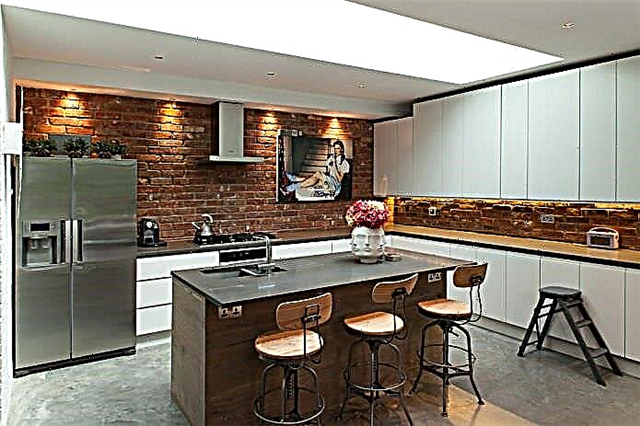
In the photo, the red brick organically looks in the modern interior with lighting, a glossy facade and marble floor.
Modern style
In modern kitchens, you can pick up a glossy stone, stone finish (Venetian plaster), rough natural, painted gypsum stone. It is important to choose the right color, which will be the background for the headset, or will become the main highlight.
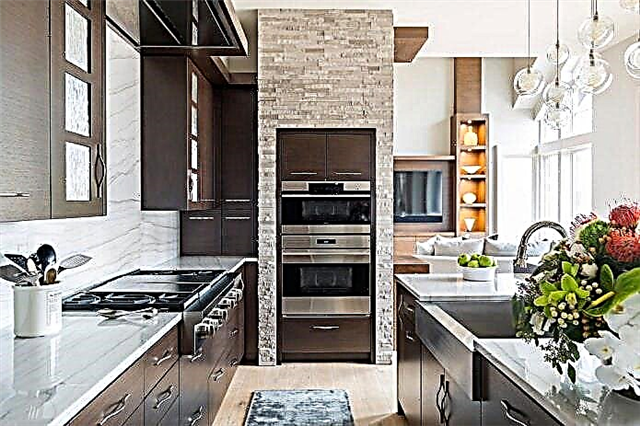

The photo shows a bright kitchen with masonry in the apron area, which in color is combined with a countertop and a set.
Classic
The classic style allows facing only from natural expensive breeds in yellow, brown, white. Flat masonry or panels made of onyx and marble will decorate the apron and wall of the dining table.


The loft is created in the kitchen with the help of gray, red stone on an apron or on one of the walls, which borders on white, gray, black painted surfaces. Set and kitchen appliances must match the interior.

Eco style
Eco style involves masonry made of natural rock in combination with wood on the floor or on the walls. If the kitchen is small, then you can do the masonry on the windowsill, part of the surface in combination with a white floor and green walls.
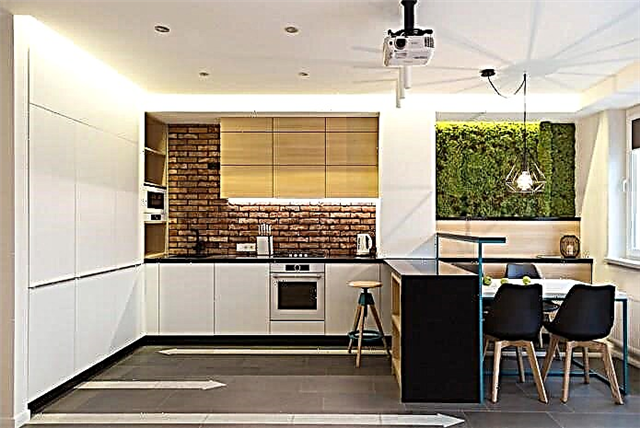
The chalet involves a combination of rough wild boulder, pebbles with a bulky wooden ceiling in dark brown and gray. This style can only be created in a spacious kitchen with large windows.

Country
Country style can be created by lining the apron and the kitchen in the hob area. The countertop or floor can also be made of stone, which differs in several tones.
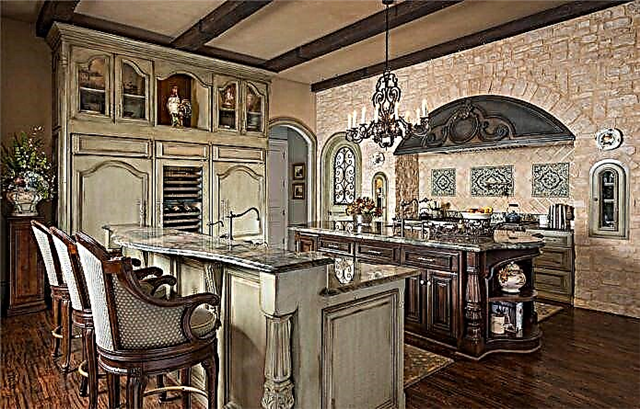

The photo shows a country-style kitchen, where flat masonry of natural stone is combined with rough wood, wooden utensils and decor.
Stone finishes
Lining the walls and design elements of the kitchen with decorative natural stone and its imitation has a number of advantages over other building and finishing materials: originality, affordable price, a wide range, ease of installation, durability, environmental friendliness, moisture and wear resistance, unpretentiousness in care, giving the interior a unique look and personality. You must admit that it’s a very impressive list to closely look at this unique finishing material! The design offers wide possibilities of using stone in the kitchen:
A small dining room "loves" bright colors. Therefore, the use in the decoration of "light" non-gloomy material is justified and even preferable. It can be an imitation of slate, shell rock, classic brick. A marble mosaic will be presentable. This will bring the interior closer to the classic style.
The dining area is decorated in a modern style with decorative stone under Jurassic marble and mountain flagstone.
An attractive look of the kitchen is possible when using decorative stone in the decoration of the apron of the kitchen set. The gas panel, highlighted by brick variations, turns into a semblance of an elegant fireplace.
The lounge corner, accented by decorative stone, becomes original cozy, "sending" in the fantasies of the audience in the medieval era.
Decoration with decorative stone creating the atmosphere of the Middle Ages in the kitchen
To create the spirit of the Middle Ages in the kitchen, choose natural decoration materials. The ideal option, in this case, would be the use of decorative stone. You can use any stone in the interior of the kitchen: slate, limestone, sandstone, cobblestone. This material can be large or small. It can have a relief and smooth texture. As for the color scheme, there are practically no restrictions.

The total dominance of stone in the decoration will create the atmosphere of the Middle Ages in the kitchen
In the manufacture of artificial decorative stone, various materials can be used: textured limestone, sandstone, gypsum.
Attention! If you are looking for a budget option for finishing the kitchen, pay attention to the plaster decorative stone. It naturally mimics natural material, and is distinguished by practicality, durability and reasonable cost.
To create a medieval atmosphere, you can partially stone the walls with stone. Select the columns, arch, door and window openings.

Partial cladding of walls and columns with decorative stone
Pay particular attention to the finish of the ventilation duct. Use artificial stone to disguise it as a pillar or a raised fireplace.

Decorative stone hides the hood over the stove and brings a touch of the Middle Ages
Attention! Decorating a kitchen with decorative stone is an expensive type of repair. But such an interior looks luxurious. On the walls, you can lay out both solid material and its fragments. By the way, with the help of fragments an original and interesting design is created.

A large stone wall looks like part of a fortification
Tips and ideas for decorating a kitchen with artificial stone
If you follow the recommendations of professionals, you can make exclusive designs in the kitchens. For a visual increase in space, lay out the decorative stone horizontally. And for the decoration of dining areas, it is worth choosing soft and soft tones.
In conclusion, I would like to add that the decorative stone in the interior of the kitchen looks unusually aesthetically pleasing. It captivates with its unique structure, interesting texture and overflow of colors. Due to the ease of installation, decorative stone is widely used in modern kitchens. He is able to hide minor defects and imperfections of surfaces, create an original ornament, and make the room unique. Use decorative stone in your kitchens, and enjoy its ease of use, aesthetic appearance and durability.
Apron trim
The stone will create a stunning apron. Harmoniously matched to the kitchen set, it will emphasize ideality and unity. It is worth choosing those that are not afraid of cleaning using detergents and abrasive products, since this surface quickly and very dirty.
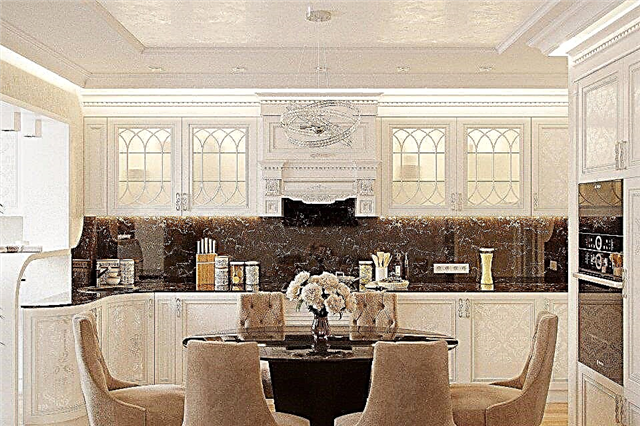
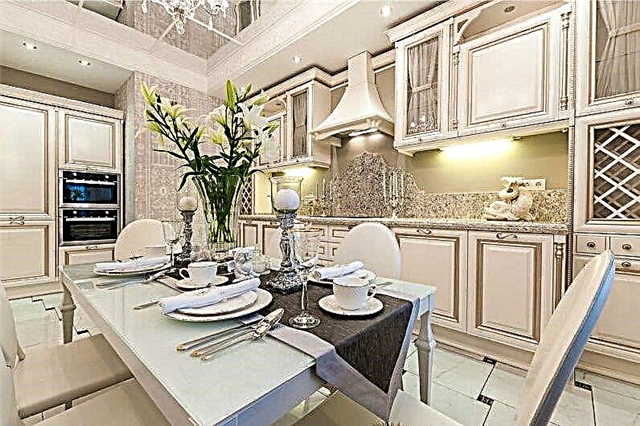
Finishing doorways and arches
Such a decorative element will effectively highlight the doorway and give a finished image. Fragments can be pasted continuously and have an even border, and can be arranged randomly.
